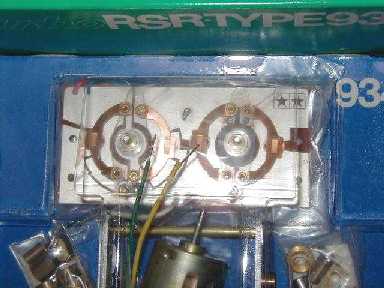
Cover of instruction manual with blue grid to give it the engineering look. Back in 1976, remote control is still considered a specialized hobby. License is required to operate the R/C equipment.

General warnings pertaining to R/C hobby. Interesting that they include planes and boats eventhough this is only a car kit.

Suggestion for running the cars. Things like this seems so obvious. Back then, this was still a new hobby. People at the park would aimlessly drive their cars in circles.

Use of hex nut to drive wheels would become standard Tamiya practice on
road cars. A plastic wrench is included in the kit. All latter kits include
metal cross wrench.
This car used spring on gearbox for suspension. After the next car, Tamiya abandoned it for use of chasis flex for suspension.
Collar was used to secure axel in place. Soon after, spacers are used for more consistent placement of axel.

The gear box contain double reduction. This is to keep the speed of motor up so it would generate high back EMF to reduce current consumption. Current consumption is an important consideration given tha the car use dry cell. The use of RS360 motor is quite underpowered for this car. All latter cars use at least RS380 motors. Dry cells were option on Tamiya cars up to the XR311 series with their RS540 motors. I must be quite expensive running dry cells on those large motors! With double reduction and dry cell, this car travel at only 5mph. Snail craw compared to today's cars. The intent of this car seem to be more of demonstrating the feasibility of a radio controlled vehicle rather than building a high performance vehicle.

The steering upright looks quite vulnerable with only the bottom attachment
points. This design probably came from Tamiya's Educational Construction
Series models, which was established before the remote control cars. Those
educational series models consist of many interesting bare bone chasis.
They are used to demonstrate mechanical concepts in various vehicles.
They also teach construction technique for moving mechanical parts. This
Porsche in a way is a follow on of that idea. To demonstrate the concept
of a remote control vehicle. Performance were latter incorporated into
their cars. From the Lamborghini on, Tamiya used a knucle to hold the
steering arm on both the top and bottom for a stiffer assembly.

Speed control for Porsche shown.This is quite a large and complicated
one compared to all latter one which are much more compact and simple.
A clear plastic connecting link actuate both selector switches at the
same time. One selector is for forward / reverse. The other selector is
for speed.

The axel for front wheel is adopted from a screw with a locknut. This is quite primative compared to latter vehicles. That again must follow the line of thought from their Educational Construction Series which have similar basic construction methods. The primative mechanism adopted to a high quality scale model body is part of what makes this car attractive then. It is interesting to see how cars evolved over time. The reciever battery is mounted behind the rear axel. This must be in part to similate the tail heavyness of the real Porsche. Other cars have battery mounted between the axels.